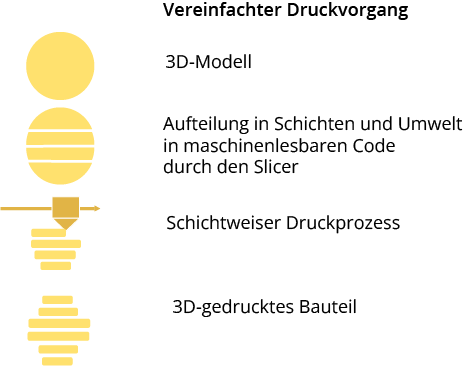©Adobe Stock/211011621
3 D printing
Prototyping made easy!
3D Printing is an additive manufacturing process that is particularly suitable for prototype construction, individual pieces and components with complex geometry. Here, a computer-generated 3D model is divided into individual layers and then assembled in layers. Depending on the printing process used, 3D plastics, resins or metals may be printed.
State of play
The 3D printing of plastics is already well researched and there are numerous suppliers of 3D printers in different price segments. In addition to the resulting printing quality, the price also determines reliability and user-friendliness. The associated software is also often easily applicable, as manufacturers focus not only on industrial customers but also on amateur 3D printers. Therefore, 3D printing is suitable for SMEs. Note: The chances of one of your employees having a 3D printer privately are nowadays relatively high.
While 3D printing of metal (and other special materials) is already used in industry, it is still an active subject of research and its use is not trivial. This requires a thorough understanding of material science and the printing process in order to select a suitable material on the one hand and to print or handle it in accordance with professional practice on the other. The current relatively high level of complexity and acquisition cost makes the use of 3D metal printing in SMEs only to a limited extent.
Technology and deployment
Description of technology
First, a three-dimensional model generated on the computer is converted or triangulated into a suitable format, usually the STL format. The conversion thus approximates the surface of the model by triangles. The model is then divided into individual layers by the so-called ‘slicer’ software, which is then converted into a machine-readable code. The code thus created allows the 3D printer to be able to produce the individual layers produced sequentially.
The way in which the respective layers are produced depends on the 3D printing method used. Two typical methods are FDM (Fused Depostion Modeling), in which the filament (the material to be printed) is melted and extruded and stereolithography (SLA) is either hardened by UV radiation or powder is melted by lasers or electron beams. Depending on the end-use application, 3D pressure parts must be retreated (surface quality, accuracy, material self-assembly).

Gradual introduction
Step 1: Selection of the operational area/framework
Step 2: Selection of 3D printer and related software
Step 3: Job design
Step four: Removal and training of staff
Opportunities for SMEs
contact
Use our technology radar to keep a look at the main technologies relevant to SMEs!
